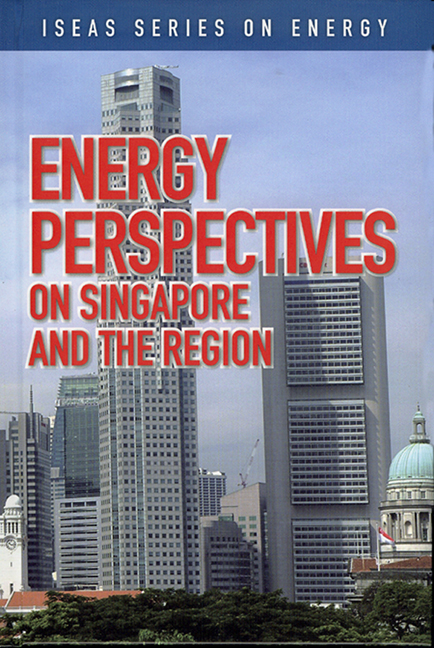Book contents
- Frontmatter
- Contents
- Foreword
- Preface
- The Contributors
- 1 Overview of Singapore's Energy Situation
- 2 Singapore's Changing Landscapes in Energy
- 3 Singapore's Role as a Key Oil Trading Centre in Asia
- 4 Large-Scale Solar PV Power Generation in Urban High-Rise Buildings in Singapore
- 5 The High-Carbon Story of Urban Development in Southeast Asia
- 6 Renewable Energy and the Environment: Technology and Economic Perspectives
- 7 Delivering Results in a Booming Rig Market
- 8 The Success Story of Rig Building in Singapore
- 9 The Singapore Oil Situation
- 10 Singapore Petroleum Company: Adding Value to the Singapore Oil Industry
- 11 Oil Storage: The Singapore Story
- REGIONAL and INTERNATIONAL
- 12 The Outlook for Energy: A View to 2030
- 13 India's Energy Situation: The Need to Secure Energy Resources in an Increasingly Competitive Environment
- 14 The Implications and Impacts of China's Oil Demand on the Asia Pacific
- 15 Energy Security Cooperation in Asia: An ASEAN-SCO Energy Partnership?
- 16 China's Energy Security: Geo-politics versus Interdependence
- 17 The Strategic Challenges for the United States and China in Global Energy Supply
- 18 China's Coal: Curse or Blessing
- 19 Japan's New Energy Strategy
- 20 Who Wins in the Asian Scramble for Oil?
- 21 New Horizons for Liquefied Natural Gas (LNG) East of Suez
- 22 Bio and Synthetic Fuels: An Alternative for Sustainable Mobility
- 23 Price Discovery for Middle East Refined Product Exports: A Natural Role for Dubai
- 24 The Outlook for Gas in Southeast Asia
- 25 Sakhalin-2 Project, a New Energy Source for the Asia Pacific: History in the Making
- Index
19 - Japan's New Energy Strategy
from REGIONAL and INTERNATIONAL
Published online by Cambridge University Press: 21 October 2015
- Frontmatter
- Contents
- Foreword
- Preface
- The Contributors
- 1 Overview of Singapore's Energy Situation
- 2 Singapore's Changing Landscapes in Energy
- 3 Singapore's Role as a Key Oil Trading Centre in Asia
- 4 Large-Scale Solar PV Power Generation in Urban High-Rise Buildings in Singapore
- 5 The High-Carbon Story of Urban Development in Southeast Asia
- 6 Renewable Energy and the Environment: Technology and Economic Perspectives
- 7 Delivering Results in a Booming Rig Market
- 8 The Success Story of Rig Building in Singapore
- 9 The Singapore Oil Situation
- 10 Singapore Petroleum Company: Adding Value to the Singapore Oil Industry
- 11 Oil Storage: The Singapore Story
- REGIONAL and INTERNATIONAL
- 12 The Outlook for Energy: A View to 2030
- 13 India's Energy Situation: The Need to Secure Energy Resources in an Increasingly Competitive Environment
- 14 The Implications and Impacts of China's Oil Demand on the Asia Pacific
- 15 Energy Security Cooperation in Asia: An ASEAN-SCO Energy Partnership?
- 16 China's Energy Security: Geo-politics versus Interdependence
- 17 The Strategic Challenges for the United States and China in Global Energy Supply
- 18 China's Coal: Curse or Blessing
- 19 Japan's New Energy Strategy
- 20 Who Wins in the Asian Scramble for Oil?
- 21 New Horizons for Liquefied Natural Gas (LNG) East of Suez
- 22 Bio and Synthetic Fuels: An Alternative for Sustainable Mobility
- 23 Price Discovery for Middle East Refined Product Exports: A Natural Role for Dubai
- 24 The Outlook for Gas in Southeast Asia
- 25 Sakhalin-2 Project, a New Energy Source for the Asia Pacific: History in the Making
- Index
Summary
Resource-poor Japan is barrelling ahead to rev up its energy security, driven by the specter of another oil crisis, the global rush for energy resources and a simmering gas dispute with China.
Japan's Ministry of Economy, Trade and Industry (METI) released publicly the New National Energy Strategy at the end of May 2006, which calls for, among other things, reduction in the oil-dependency rate to 40 per cent or less by 2030 from the current 50 per cent, promotion of nuclear energy, and securing of energy resources abroad through the fostering of more powerful energy companies.
Apparently in tandem with the new government energy-security policy, the nation's controversial nuclear fuel cycle policy has entered a new phase. The government unveiled a plan to construct a new one trillion yen (US$8.7 billion) fast-breeder reactor, and domestic power firms also announced their plutonium utilization plans in January, ahead of the start in March of a key test operation to extract plutonium at a spent-nuclear-fuel reprocessing facility. In another important development, Inpex Corp and Teikoku Oil Co, Japan's Number One and Number Three oil developers, integrated their operations under a joint holding company in April in a bid to survive cut-throat competition on the global scene.
The New National Energy Strategy also emphasizes the importance of stepped-up assistance to help Asian neighbours with energy-saving efforts and strengthened relations with resource-rich countries through such steps as concluding a free trade agreement, or FTA.
These Japanese moves toward greater energy security come amid growing concerns about whether the nation will be able to ensure stable oil and other energy supplies to fuel its economy, the world's second largest. Crude oil prices are stuck at near record levels of around US$70 per barrel in world markets.
Amid the stubbornly high oil prices, the global competition for oil reserves is intensifying.
- Type
- Chapter
- Information
- Energy Perspectives on Singapore and the Region , pp. 228 - 248Publisher: ISEAS–Yusof Ishak InstitutePrint publication year: 2007

